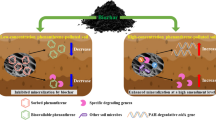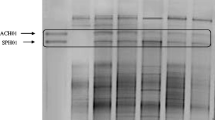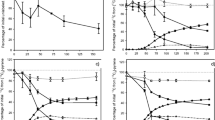Abstract
Co-contaminations of soils with organic and inorganic pollutants are a frequent environmental problem. Due to their toxicity and recalcitrance, the heterogeneous pollutants may persist in soil. The hypothesis of this study was that degradation of polycyclic aromatic hydrocarbons (PAHs) is enhanced if heavy metals in soil are immobilized and their bioavailability reduced. For metal immobilization and enhanced biodegradation, distinct mineral and organic soil amendments (iron oxides, gravel sludge, biochar) were deployed in an incubation batch experiment. The second part of the experiment consisted of a greenhouse pot experiment applying fast-growing and pollution-tolerant woody plants (willow and black locust). Soil amendments initially immobilized NH4NO3-extractable zinc, cadmium, and lead; after 100 days of incubation, soil amendments showed reductions only for cadmium and a tendency to enhance arsenic mobility. In order to monitor the remediation success, a 13C-phenanthrene (PHE) label was applied. 13C-phospholipid fatty acid analysis (13C-PLFA) further enabled the identification of PHE-degrading soil microorganisms. Both experiments exhibited a similar PLFA profile. Gram-negative bacteria (esp. cy17:0, 16:1ω7 + 6, 18:1ω7c) were the most significant microbial group taking up 13C-PHE. Plants effectively increased the label uptake by gram-positive bacteria and increased the biomass of the fungal biomarker, although their contribution to the degradation process was minor. Plants tended to prolong PAH dissipation in soil; at the end of the experiment, however, all treatments showed equally low total PAH concentrations in soil. While black locust plants tended not to take up potentially toxic trace elements, willows accumulated them in their leaves. The results of this study show that the chosen treatments did not enhance the remediation of the experimental soil.





Similar content being viewed by others
Abbreviations
- BCF:
-
bioconcentration factor
- CEC:
-
cation exchange capacity
- N:
-
nitrogen
- PAH:
-
polycyclic aromatic hydrocarbon
- PHE:
-
phenanthrene
- PLFA:
-
phospholipid fatty acid
- TE:
-
trace elements
References
Ahmad M, Rajapaksha AU, Lim JE, Zhang M, Bolan N, Mohan D, Vithanage M, Lee SS, Ok YS (2014) Biochar as a sorbent for contaminant management in soil and water: a review. Chemosphere 99:19–33. https://doi.org/10.1016/j.chemosphere.2013.10.071
Amor L, Kennes C, Veiga M (2001) Kinetics of inhibition in the biodegradation of monoaromatic hydrocarbons in presence of heavy metals. Bioresour Technol 78(2):181–185. https://doi.org/10.1016/S0960-8524(00)00182-6
Anderson CR, Condron LM, Clough TJ, Fiers M, Stewart A, Hill RA, Sherlock RR (2011) Biochar induced soil microbial community change: implications for biogeochemical cycling of carbon, nitrogen and phosphorus. Pedobiologia 54(5–6):309–320. https://doi.org/10.1016/j.pedobi.2011.07.005
Austrian Standards Institute (2013) Chemische Bodenuntersuchungen ― Verfahren zur Extraktion von Elementen mit Salpetersäure- Perchlorsäure-Gemisch. (L 1085).
Austrian Standards Institute (2014) Kontaminierte Standorte - Teil 2: Nutzungsspezifische Beurteilung der Verunreinigungen des Bodens von Altstandorten und Altablagerungen.(ÖNORM S 2088-2).
Bandara T, Herath I, Kumarathilaka P, Seneviratne M, Seneviratne G, Rajakaruna N, Vithanage M, Ok YS (2017) Role of woody biochar and fungal-bacterial co-inoculation on enzyme activity and metal immobilization in serpentine soil. J Soils Sediments 17(3):665–673. https://doi.org/10.1007/s11368-015-1243-y
Beesley L, Moreno-Jiménez E, Gomez-Eyles JL (2010) Effects of biochar and greenwaste compost amendments on mobility, bioavailability and toxicity of inorganic and organic contaminants in a multi-element polluted soil. Environ Pollut 158(6):2282–2287. https://doi.org/10.1016/j.envpol.2010.02.003
Bell TH, El-Din Hassan S, Lauron-Moreau A, Al-Otaibi F, Hijri M, Yergeau E, St-Arnaud M (2013) Linkage between bacterial and fungal rhizosphere communities in hydrocarbon-contaminated soils is related to plant phylogeny. ISME J 8(2):331–343. https://doi.org/10.1038/ismej.2013.149
Bezalel L, Hadar Y, Fu PP, Freeman JP, Cerniglia CE (1996) Metabolism of phenanthrene by the white rot fungus Pleurotus ostreatus. Appl Environ Microbiol 62(7):2547–2553
Biswas B, Sarkar B, Mandal A, Naidu R (2015) Heavy metal-immobilizing organoclay facilitates polycyclic aromatic hydrocarbon biodegradation in mixed-contaminated soil. J Hazard Mater 298:129–137. https://doi.org/10.1016/j.jhazmat.2015.05.009
Boonchan S, Britz ML, Stanley GA (2000) Degradation and mineralization of high-molecular-weight polycyclic aromatic hydrocarbons by defined fungal-bacterial cocultures. Appl Environ Microbiol 66(3):1007–1019
Boschker H, Middelburg J (2002) Stable isotopes and biomarkers in microbial ecology. FEMS Microbiology Ecology 40 (2002) 85^95(40):85–95.
Broeckling CD, Broz AK, Bergelson J, Manter DK, Vivanco JM (2008) Root exudates regulate soil fungal community composition and diversity. Appl Environ Microbiol 74(3):738–744. https://doi.org/10.1128/AEM.02188-07
Cébron A, Louvel B, Faure P, France-Lanord C, Chen Y, Murrell JC, Leyval C (2011) Root exudates modify bacterial diversity of phenanthrene degraders in PAH-polluted soil but not phenanthrene degradation rates. Environ Microbiol 13(3):722–736. https://doi.org/10.1111/j.1462-2920.2010.02376.x
Chen Y, Murrell JC (2010) DNA stable isotope probing. In: Chen Y, Murrell JC (eds) DNA stable isotope probing.
Chigbo C, Batty L (2013) Phytoremediation potential of Brassica juncea in Cu-pyrene co-contaminated soil: comparing freshly spiked soil with aged soil. J Environ Manag 129:18–24. https://doi.org/10.1016/j.jenvman.2013.05.041
Clough T, Condron L, Kammann C, Müller C (2013) A review of biochar and soil nitrogen dynamics. Agronomy 3(2):275–293. https://doi.org/10.3390/agronomy3020275
Denef K, Roobroeck D, Manimel Wadu MCW, Lootens P, Boeckx P (2009) Microbial community composition and rhizodeposit-carbon assimilation in differently managed temperate grassland soils. Soil Biol Biochem 41(1):144–153. https://doi.org/10.1016/j.soilbio.2008.10.008
El Amrani A, Dumas A-S, Wick LY, Yergeau E, Berthomé R (2015) “Omics” insights into PAH degradation toward improved green remediation biotechnologies. Environ Sci Technol 49(19):11281–11291. https://doi.org/10.1021/acs.est.5b01740
European Commission (ed) (2002) Opinion of the SCF on the risks to human health of polycyclic aromatic hydrocarbons in food. SCF/CS/CNTM/PAH/29 Final
European Environment Agency (2014) Progress in management of contaminated sites. https://www.eea.europa.eu/data-and-maps/indicators/progress-in-management-of-contaminated-sites-3/assessment. Accessed 20 Jun 2017.
Friesl-Hanl W, Platzer K, Horak O, Gerzabek MH (2009) Immobilising of Cd, Pb, and Zn contaminated arable soils close to a former Pb/Zn smelter: a field study in Austria over 5 years. Environ Geochem Health 31(5):581–594. https://doi.org/10.1007/s10653-009-9256-3
Frišták V, Pipíška M, Lesný J, Soja G, Friesl-Hanl W, Packová A (2015) Utilization of biochar sorbents for Cd2+, Zn2+, and Cu2+ ions separation from aqueous solutions: comparative study. Environ Monit Assess 187(1). https://doi.org/10.1007/s10661-014-4093-y
Frostegård Å, Tunlid A, Bååth E (1993) Phospholipid fatty acid composition, biomass, and activity of microbial communities from two soil types experimentally exposed to different heavy metals. Appl Environ Microbiol 59(11):3605–3617
Gan S, Lau E, Ng H (2009) Remediation of soils contaminated with polycyclic aromatic hydrocarbons (PAHs). J Hazard Mater 172(2–3):532–549. https://doi.org/10.1016/j.jhazmat.2009.07.118
Ghosal D, Ghosh S, Dutta TK, Ahn Y (2016) Current state of knowledge in microbial degradation of polycyclic aromatic hydrocarbons (PAHs): a review. Front Microbiol 7(386):107. https://doi.org/10.3389/fmicb.2016.01369
Giller KE, Witter E, McGrath SP (2009) Heavy metals and soil microbes. Soil Biol Biochem 41(10):2031–2037. https://doi.org/10.1016/j.soilbio.2009.04.026
Granzin S, Valtl M (2016) Verdachtsflächenkataster und Altlastenatlas. http://www.umweltbundesamt.at. Accessed 20 Jun 2017.
Gutiérrez-Ginés M, Hernández A, Pérez-Leblic M, Pastor J, Vangronsveld J (2014) Phytoremediation of soils co-contaminated by organic compounds and heavy metals: bioassays with Lupinus luteus L. and associated endophytic bacteria. J Environ Manag 143:197–207. https://doi.org/10.1016/j.jenvman.2014.04.028
Haritash A, Kaushik C (2009) Biodegradation aspects of polycyclic aromatic hydrocarbons (PAHs): a review. J Hazard Mater 169(1–3):1–15. https://doi.org/10.1016/j.jhazmat.2009.03.137
Harris D, Horwáth WR, van Kessel C (2001) Acid fumigation of soils to remove carbonates prior to total organic carbon or CARBON-13 isotopic analysis. Soil Sci Soc Am J 65(6):1853. https://doi.org/10.2136/sssaj2001.1853
He S, Feng Y, Ren H, Zhang Y, Gu N, Lin X (2011) The impact of iron oxide magnetic nanoparticles on the soil bacterial community. J Soils Sediments 11(8):1408–1417. https://doi.org/10.1007/s11368-011-0415-7
Hobbs RJ, Streit B (1986) Heavy metal concentrations in plants growing on a copper mine spoil in the Grand Canyon, Arizona. Am Midl Nat 115(2):277–281. https://doi.org/10.2307/2425864
Huang S, Jia X, Zhao Y, Chang Y, Bai B (2016a) Response of Robinia pseudoacacia L. rhizosphere microenvironment to Cd and Pb contamination and elevated temperature. Appl Soil Ecol 108:269–277. https://doi.org/10.1016/j.apsoil.2016.09.002
Huang X, Zhu-Barker X, Horwath WR, Faeflen SJ, Luo H, Xin X, Jiang X (2016b) Effect of iron oxide on nitrification in two agricultural soils with different pH. Biogeosciences 13(19):5609–5617. https://doi.org/10.5194/bg-13-5609-2016
International Organization for Standardization (2008) Soil quality—extraction of trace elements from soil using ammonium nitrate solution (19730).
Johnsen AR, Wick LY, Harms H (2005) Principles of microbial PAH-degradation in soil. Environ Pollut 133(1):71–84. https://doi.org/10.1016/j.envpol.2004.04.015
Johnsen AR, Winding A, Karlson U, Roslev P (2002) Linking of microorganisms to phenanthrene metabolism in soil by analysis of 13C-labeled cell lipids. Appl Environ Microbiol 68(12):6106–6113. https://doi.org/10.1128/AEM.68.12.6106-6113.2002
Joner EJ, Leyval C (2003) Rhizosphere gradients of polycyclic aromatic hydrocarbon (PAH) dissipation in two industrial soils and the impact of arbuscular mycorrhiza. Environ Sci Technol 37(11):2371–2375. https://doi.org/10.1021/es020196y
Kammann CI, Schmidt H-P, Messerschmidt N, Linsel S, Steffens D, Müller C, Koyro H-W, Conte P, Stephen J (2015) Plant growth improvement mediated by nitrate capture in co-composted biochar. Sci Rep 5:11,080. https://doi.org/10.1038/srep11080
Karer J, Wawra A, Zehetner F, Dunst G, Wagner M, Pavel P-B, Puschenreiter M, Friesl-Hanl W, Soja G (2015) Effects of biochars and compost mixtures and inorganic additives on immobilisation of heavy metals in contaminated soils. Water Air Soil Pollut 226(10). https://doi.org/10.1007/s11270-015-2584-2
Kaur A, Chaudhary A, Kaur A, Choudhary R (2005) Phospholipid fatty acid—a bioindicator of environment monitoring and assessment in soil ecosystem. Curr Sci 89(7):1103–1112
Kim Y-B, Park KY, Chung Y, Oh K-C, Buchanan BB (2004) Phytoremediation of anthracene contaminated soils by different plant species. J Plant Biol 47(3):174–178
Kloss S, Zehetner F, Buecker J, Oburger E, Wenzel WW, Enders A, Lehmann J, Soja G (2015) Trace element biogeochemistry in the soil-water-plant system of a temperate agricultural soil amended with different biochars. Environ Sci Pollut Res 22(6):4513–4526. https://doi.org/10.1007/s11356-014-3685-y
Kołtowski M, Hilber I, Bucheli TD, Oleszczuk P (2016) Effect of activated carbon and biochars on the bioavailability of polycyclic aromatic hydrocarbons in different industrially contaminated soils. Environ Sci Pollut Res 23(11):11,058–11,068. https://doi.org/10.1007/s11356-016-6196-1
Lehmann J, Rillig MC, Thies J, Masiello CA, Hockaday WC, Crowley D (2011) Biochar effects on soil biota—a review. Soil Biol Biochem 43(9):1812–1836. https://doi.org/10.1016/j.soilbio.2011.04.022
Lin Q, Shen K-L, Zhao H-M, Li W-H (2008) Growth response of Zea mays L. in pyrene–copper co-contaminated soil and the fate of pollutants. J Hazard Mater 150(3):515–521. https://doi.org/10.1016/j.jhazmat.2007.04.132
Liu L, Chen P, Sun M, Shen G, Shang G (2015) Effect of biochar amendment on PAH dissipation and indigenous degradation bacteria in contaminated soil. J Soils Sediments 15(2):313–322. https://doi.org/10.1007/s11368-014-1006-1
Mandal A, Biswas B, Sarkar B, Patra AK, Naidu R (2016) Surface tailored organobentonite enhances bacterial proliferation and phenanthrene biodegradation under cadmium co-contamination. Sci Total Environ 550:611–618. https://doi.org/10.1016/j.scitotenv.2016.01.164
Marchal G, Smith KE, Rein A, Winding A, Trapp S, Karlson UG (2013) Comparing the desorption and biodegradation of low concentrations of phenanthrene sorbed to activated carbon, biochar and compost. Chemosphere 90(6):1767–1778. https://doi.org/10.1016/j.chemosphere.2012.07.048
Martin F, Torelli S, Le Paslier D, Barbance A, Martin-Laurent F, Bru D, Geremia R, Blake G, Jouanneau Y (2012) Betaproteobacteria dominance and diversity shifts in the bacterial community of a PAH-contaminated soil exposed to phenanthrene. Environ Pollut 162:345–353. https://doi.org/10.1016/j.envpol.2011.11.032
Meagher RB (2000) Phytoremediation of toxic elemental and organic pollutants. Curr Opin Plant Biol 3(2):153–162. https://doi.org/10.1016/S1369-5266(99)00054-0
Mellendorf M, Soja G, Gerzabek MH, Watzinger A (2010) Soil microbial community dynamics and phenanthrene degradation as affected by rape oil application. Appl Soil Ecol 46(3):329–334. https://doi.org/10.1016/j.apsoil.2010.10.008
Meng L, Qiao M, Arp, Hans Peter H. (2011) Phytoremediation efficiency of a PAH-contaminated industrial soil using ryegrass, white clover, and celery as mono- and mixed cultures. J Soils Sediments 11(3):482–490. https://doi.org/10.1007/s11368-010-0319-y
Nam K, Moon HS, Kim JY, Kukor JJ (2002) Linkage between biodegradation of polycyclic aromatic hydrocarbons and phospholipid profiles in soil isolates. J Microbiol Biotechnol 12(1):77–83
Ogbonnaya U, Semple K (2013) Impact of biochar on organic contaminants in soil: a tool for mitigating risk? Agronomy 3(2):349–375. https://doi.org/10.3390/agronomy3020349
Olaniran A, Balgobind A, Pillay B (2013) Bioavailability of heavy metals in soil: impact on microbial biodegradation of organic compounds and possible improvement strategies. IJMS 14(5):10197–10228. https://doi.org/10.3390/ijms140510197
Palmroth MRT, Koskinen PEP, Kaksonen AH, Münster U, Pichtel J, Puhakka JA (2007) Metabolic and phylogenetic analysis of microbial communities during phytoremediation of soil contaminated with weathered hydrocarbons and heavy metals. Biodegradation 18(6):769–782. https://doi.org/10.1007/s10532-007-9105-y
Rajkumar M, Sandhya S, Prasad M, Freitas H (2012) Perspectives of plant-associated microbes in heavy metal phytoremediation. Biotechnol Adv 30(6):1562–1574. https://doi.org/10.1016/j.biotechadv.2012.04.011
Rees F, Simonnot MO, Morel JL (2014) Short-term effects of biochar on soil heavy metal mobility are controlled by intra-particle diffusion and soil pH increase. Eur J Soil Sci 65(1):149–161. https://doi.org/10.1111/ejss.12107
Rhodes AH, Riding MJ, McAllister LE, Lee K, Semple KT (2012) Influence of activated charcoal on desorption kinetics and biodegradation of phenanthrene in soil. Environ Sci Technol 46(22):12,445–12,451. https://doi.org/10.1021/es3025098
Shen G, Lu Y, Zhou Q, Hong J (2005) Interaction of polycyclic aromatic hydrocarbons and heavy metals on soil enzyme. Chemosphere 61(8):1175–1182. https://doi.org/10.1016/j.chemosphere.2005.02.074
Sneath HE, Hutchings TR, de Leij FA (2013) Assessment of biochar and iron filing amendments for the remediation of a metal, arsenic and phenanthrene co-contaminated soil. Environ Pollut 178:361–366. https://doi.org/10.1016/j.envpol.2013.03.009
Soja, G (2016) Interactions of biochar and biological degradation of aromatic hydrocarbons in contaminated soil. Biochar Application: Essential Soil Microbial Ecology: https://doi.org/10.1016/j.apgeochem.2017.06.004
Sprocati AR, Alisi C, Tasso F, Marconi P, Sciullo A, Pinto V, Chiavarini S, Ubaldi C, Cremisini C (2012) Effectiveness of a microbial formula, as a bioaugmentation agent, tailored for bioremediation of diesel oil and heavy metal co-contaminated soil. Process Biochem 47(11):1649–1655. https://doi.org/10.1016/j.procbio.2011.10.001
Stolte J, Tesfai M, Øygarden L, Kværnø S, Keizer J, Verheijen F, Panagos P, Ballabio C, Hessel R (2016) Soil threats in Europe: status, methods, drivers and effects on ecosystem services. JRC Sci Hub. https://doi.org/10.2788/828742
Sun Y, Zhou Q, Xu Y, Wang L, Liang X (2011) Phytoremediation for co-contaminated soils of benzo[a]pyrene (B[a]P) and heavy metals using ornamental plant Tagetes patula. J Hazard Mater 186(2–3):2075–2082. https://doi.org/10.1016/j.jhazmat.2010.12.116
Sutherland JB (1992) Detoxification of polycyclic aromatic hydrocarbons by fungi. J Ind Microbiol 9(1):53–61. https://doi.org/10.1007/BF01576368
Szolar OHJ, Rost H, Braun R, Loibner AP (2002) Analysis of polycyclic aromatic hydrocarbons in soil. Minimizing sample pretreatment using automated soxhlet with ethyl acetate as extraction solvent. Anal Chem 74(10):2379–2385. https://doi.org/10.1021/ac01573 9 l
Thavamani P, Malik S, Beer M, Megharaj M, Naidu R (2012) Microbial activity and diversity in long-term mixed contaminated soils with respect to polyaromatic hydrocarbons and heavy metals. J Environ Manag 99:10–17. https://doi.org/10.1016/j.jenvman.2011.12.030
Thomas F, Lorgeoux C, Faure P, Billet D, Cébron A (2016) Isolation and substrate screening of polycyclic aromatic hydrocarbon degrading bacteria from soil with long history of contamination. Int Biodeterior Biodegrad 107:1–9. https://doi.org/10.1016/j.ibiod.2015.11.004
Touceda-González M, Brader G, Antonielli L, Ravindran VB, Waldner G, Friesl-Hanl W, Corretto E, Campisano A, Pancher M, Sessitsch A (2015) Combined amendment of immobilizers and the plant growth-promoting strain Burkholderia phytofirmans PsJN favours plant growth and reduces heavy metal uptake. Soil Biol Biochem 91:140–150. https://doi.org/10.1016/j.soilbio.2015.08.038
Uhlik O, Leewis M-C, Strejcek M, Musilova L, Mackova M, Leigh MB, Macek T (2013) Stable isotope probing in the metagenomics era: a bridge towards improved bioremediation. Biotechnol Adv 31(2):154–165. https://doi.org/10.1016/j.biotechadv.2012.09.003
Watzinger A (2015) Microbial phospholipid biomarkers and stable isotope methods help reveal soil functions. Soil Biol Biochem 86:98–107. https://doi.org/10.1016/j.soilbio.2015.03.019
Watzinger A, Feichtmair S, Kitzler B, Zehetner F, Kloss S, Wimmer B, Zechmeister-Boltenstern S, Soja G (2014) Soil microbial communities responded to biochar application in temperate soils and slowly metabolized 13 C-labeled biochar as revealed by 13 C PLFA analyses: results from a short-term incubation and pot experiment. Eur J Soil Sci 65(1):40–51. https://doi.org/10.1111/ejss.12100
Wenzel WW (2009) Rhizosphere processes and management in plant-assisted bioremediation (phytoremediation) of soils. Plant Soil 321(1–2):385–408. https://doi.org/10.1007/s11104-008-9686-1
Wick AF, Haus NW, Sukkariyah BF, Kathryn C. (2011) Remediation of PAH-contaminated soils and sediments: a literature review, Blacksburg
Wood JL, Tang C, Franks AE (2016) Microbial associated plant growth and heavy metal accumulation to improve phytoextraction of contaminated soils. Soil Biol Biochem 103:131–137. https://doi.org/10.1016/j.soilbio.2016.08.021
Xu Y, Sun G-D, Jin J-H, Liu Y, Luo M, Zhong Z-P, Liu Z-P (2014) Successful bioremediation of an aged and heavily contaminated soil using a microbial/plant combination strategy. J Hazard Mater 264:430–438. https://doi.org/10.1016/j.jhazmat.2013.10.071
Yao Y, Gao B, Zhang M, Inyang M, Zimmerman AR (2012) Effect of biochar amendment on sorption and leaching of nitrate, ammonium, and phosphate in a sandy soil. Chemosphere 89(11):1467–1471. https://doi.org/10.1016/j.chemosphere.2012.06.002
Zhao F, McGrath SP, Crosland AR (1994) Comparison of three wet digestion methods for the determination of plant sulphur by inductively coupled plasma atomic emission spectroscopy (ICP-AES). Commun Soil Sci Plant Anal 25(3–4):407–418
Zhou X, Cébron A, Béguiristain T, Leyval C (2009) Water and phosphorus content affect PAH dissipation in spiked soil planted with mycorrhizal alfalfa and tall fescue. Chemosphere 77(6):709–713. https://doi.org/10.1016/j.chemosphere.2009.08.050
Acknowledgments
The authors would like to thank Joachim Heindler, Marion Graser, Christian Mayer, and Martha Klampfer for technical support in the laboratory and greenhouse.
Funding
Funding by EU and the County of Lower Austria, project no. WST3-T-81/029-2011, WST3-T-81/034-2014, WST3-T-81/036-2016, is gratefully acknowledged.
Author information
Authors and Affiliations
Corresponding author
Additional information
Responsible editor: Diane Purchase
Electronic supplementary material
ESM 1
(DOCX 85 kb)
Rights and permissions
About this article
Cite this article
Wawra, A., Friesl-Hanl, W., Jäger, A. et al. Investigations of microbial degradation of polycyclic aromatic hydrocarbons based on 13C-labeled phenanthrene in a soil co-contaminated with trace elements using a plant assisted approach. Environ Sci Pollut Res 25, 6364–6377 (2018). https://doi.org/10.1007/s11356-017-0941-y
Received:
Accepted:
Published:
Issue Date:
DOI: https://doi.org/10.1007/s11356-017-0941-y




